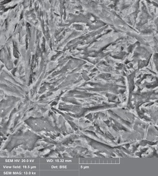Russian scientists have discovered a method to enhance the structural strength of steel used in drilling pipes.
The study has been published in the journal "Black Metals". This research was carried out as part of the strategic academic leadership program "Priority 2030".
Drill pipes must possess high strength, impact toughness, and corrosion resistance, as they are subjected to significant mechanical loads and aggressive chemical environments. Special steels—low-carbon martensitic steels—are considered promising for their production.
On one hand, these steels contain a small amount of carbon (up to 0.2 percent), which achieves an optimal combination of mechanical properties: ductility allows for easy shaping and processing of the steel to produce pipes of the desired form, while impact toughness ensures the material can withstand loads. On the other hand, the unique structure of these steels provides high strength, preventing them from failing under large external loads.
To enhance the characteristics of the steel, thermal treatment is performed—quenching from the two-phase region, where the metal is first heated to high temperatures and then rapidly cooled, altering its crystalline structure. As a result, strength, hardness, and wear resistance increase, but impact toughness decreases. The advantage of steels with this studied structure is that they simplify this process, as they can be quenched by cooling in regular air without requiring special acceleration, while significant drops in impact toughness do not occur.
Different quenching methods can have varying effects on the metal's properties. Existing grades either do not possess the necessary combination of strength, toughness, and ductility, or their production demands excessive technological and financial resources.
Scientists from Perm Polytechnic University studied the structural changes in low-carbon martensitic steel during heating and cooling and proposed a quenching method that provides a better combination of its mechanical properties.
To do this, the polytechnic researchers created samples in the form of ingots and heated them to high temperatures (800 °C and above), at which structural changes in solid-state steel occur. This process is known as quenching from the intercritical temperature range. After that, tests were conducted to determine the mechanical properties of the samples cut from the finished product.

“The experiment showed that changes in the atomic structure of the metal during heating at 5-40 °C/min occur simultaneously through two mechanisms—shear and diffusion—which can sometimes overlap. In the first mechanism, atoms shift in ‘groups,’ meaning they do not lose connections with their neighbors—this is a rapid process that allows achieving the desired structure that defines the material's properties. Notably, significant energy expenditures are not required for this,” comments Sergey Grebenkov, lead engineer of the "Metallurgy, Thermal and Laser Processing of Metals" department at PNIPU, PhD in Technical Sciences.
“At higher heating temperatures, atoms move over distances greater than interatomic—this is the diffusion mechanism, which takes longer, but it can also achieve the desired mechanical properties of steel,” explains Sergey Laptev, a graduate student at the "Metallurgy, Thermal and Laser Processing of Metals" department at PNIPU.
“As a result, we established that quenching steel from the intercritical temperature range provides the selected steel with a better combination of necessary properties compared to traditional technologies. The ultimate tensile strength is around 1300 MPa, the relative reduction is approximately 70 percent, and the impact toughness is 2.5 MJ/m2. Steel of this composition and characteristics can serve as an alternative to modern steels for drill pipes,” says Alexander Shatsov, professor at the "Metallurgy, Thermal and Laser Processing of Metals" department at PNIPU, Doctor of Technical Sciences.
The steel composition and heat treatment method proposed by the scientists from Perm Polytechnic significantly improve the material's properties. This is crucial for the production of steel drill pipes, allowing for increased structural strength. The work is protected by patent.